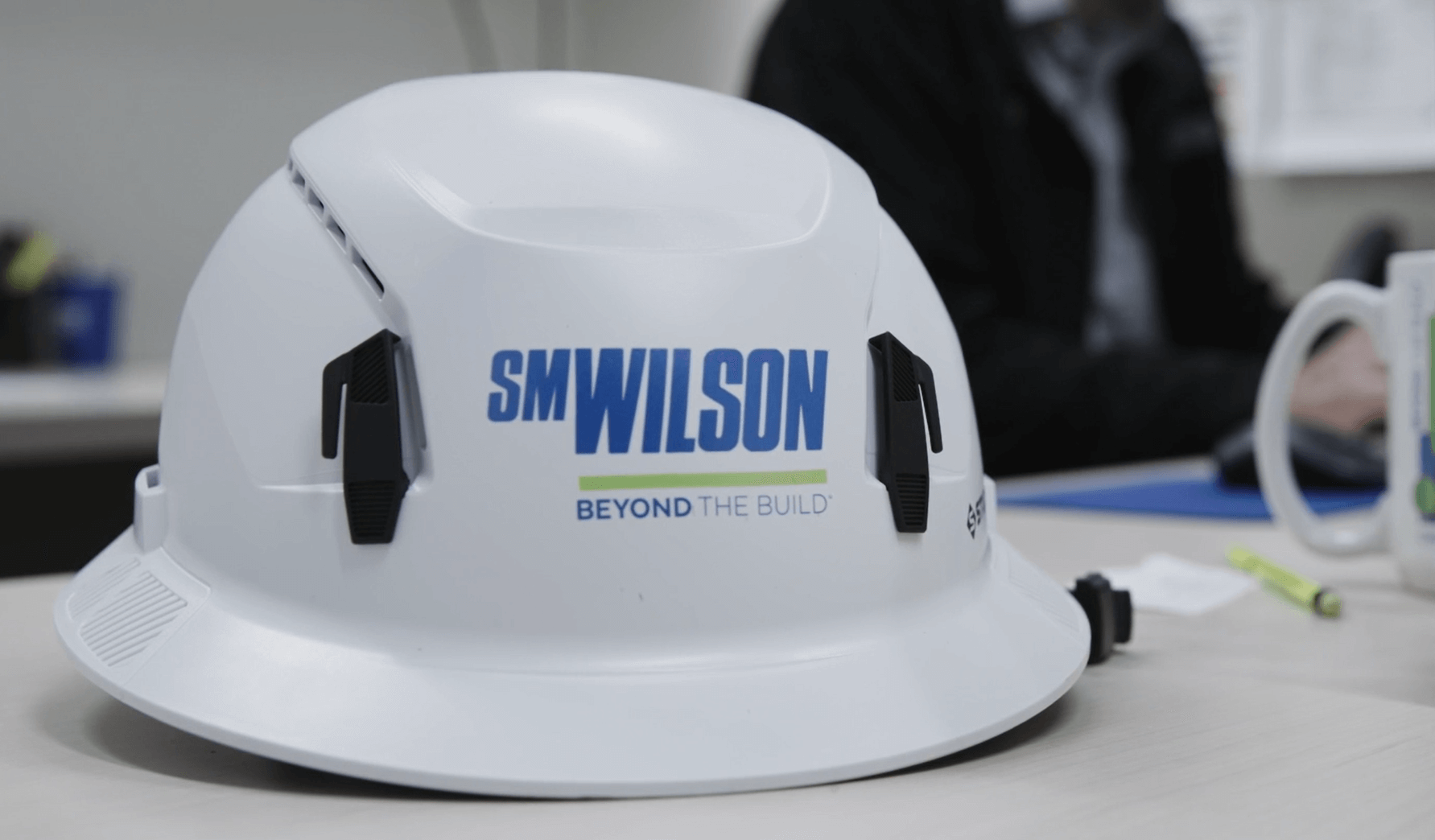The construction industry, long recognized for its inherent hazards, is experiencing a safety revolution. From cutting-edge technology to enhanced safety gear, these innovations foster a culture of well-being and security like never before.
S. M. Wilson has been providing construction management services for 100+ years. Since 2018, the Associated General Contractors of Missouri (AGCMO) has continued to recognize the company yearly with a Safety Award for recording ZERO Lost-Time Injuries. Lost time occurs when an employee is injured while carrying out a work-related task and cannot return to work. This achievement is more than a number; it reflects shared responsibility, continuous effort, and attention to detail.
Drones and 3D Scanning for Enhanced Site Monitoring
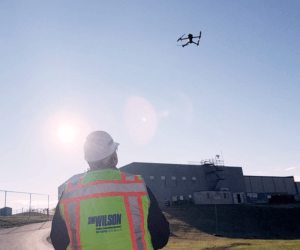 One of the biggest technological innovations in safety is using drones for aerial site inspections.
One of the biggest technological innovations in safety is using drones for aerial site inspections.
“Drones provide a bird’s-eye view of the site, making it easier to identify potential hazards,” says Tom Burns, CSP, S. M. Wilson’s Safety Director with 28 years of health and safety experience. “They have become instrumental in viewing hard-to-reach areas and allow for remote inspections, reducing the risk of falls or other accidents.”
3D scanning, often used in tandem with drones, enables safety teams to visualize potential hazards early on in a project.
“These technologies improve the planning process and help create a safer environment by proactively addressing risks before they become incidents,” Burns states.
Essential Safety Equipment of 2024
Safety Helmets vs Hard Hats
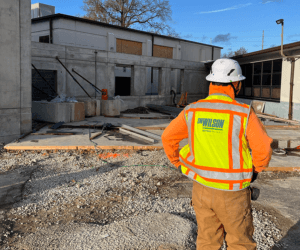 Innovations in head protection, which remained relatively the same for decades, provide a safer environment.
Innovations in head protection, which remained relatively the same for decades, provide a safer environment.
Safety helmets protect the entire head, including the sides, front, and back. Often designed with face shields or goggles to protect against dust, projectiles, and chemical splashes, some safety helmets also have built-in hearing protection or communication systems.
“Traditionally, hard hats have primarily protected the top of a worker’s head but lack sufficient side impact protection and chin straps. With the absence of chin straps, workers are susceptible to their hard hats falling off in the event of slips or trips, leaving them vulnerable,” Burns says.
Safety helmets present advantages over traditional hard hats, which date back to the 1960s. The ANSI Z89.1 Type 2 designation ensures superior impact protection, with chin straps preventing the helmet from becoming a projectile in secondary impact events. Helmets are also lightweight construction to accommodate additional interior components to enhance protection. With helmet use increasing, manufacturers have begun introducing cutting-edge accessories, including eye protection, face shields, earmuffs and headlamp keepers.
“With the evolution of head protection from traditional hard hats to safety helmets, this shows a positive shift toward an even more enhanced workplace safety,” Burns states. “With consideration of gear limitations, consultation with safety professionals and commitment to ensuring the safety of every team member every day, the industry continues to prioritize the well-being of workers.”
Enhancements in Female PPEs
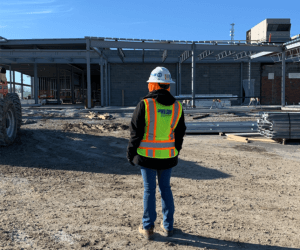 As more women enter the construction industry, improvements in PPE have greatly enhanced their comfort and safety. Understanding the impact of PPE on women in construction is increasingly vital.
As more women enter the construction industry, improvements in PPE have greatly enhanced their comfort and safety. Understanding the impact of PPE on women in construction is increasingly vital.
According to the National Center for Construction Education and Research (NCCER), now that more than 1.17 million women work in the construction industry, PPE designed for women is an essential offering and companies have been noticing. Many organizations have made it a point to advocate for appropriate safety gear for female construction workers.
“Today, manufacturers acknowledge the importance of making apparel to better fit women. As such, they’ve started to make PPE specifically designed to accommodate a range of body types and sizes. Because of the wide selection of fit available, female employees have greater opportunity to find comfortable and appropriate PPE. These options include redesigned eye, face, head and hand protection, and footwear — all of which are necessary to maintain a safe and productive work environment. Newer PPE even comes in several designs and colors, bridging a demand for both functionality and fashion,” according to ‘How Improved PPE Impacts Construction Safety for Women’ from NCCER.
S. M. Wilson’s Christine Raffety, a project engineer, has led the charge to ensure the women in the field are equipped with the right-sized PPEs. Raffety emphasizes the importance of proper PPE for all job site personnel. Ensuring everyone has the correct gear is crucial for both individual safety and overall site well-being.
“Wilson Women made inclusive PPE an objective for 2024. Women’s Safety Vests have now been distributed to all Women in operations at S. M. Wilson. Improperly fitting PPE compromises safety and can be ineffective in hazardous situations. People are more likely to wear their PPE if it fits properly,” Raffety said.
Strengthening the Focus on Mental Health to Take Care Of Each Other
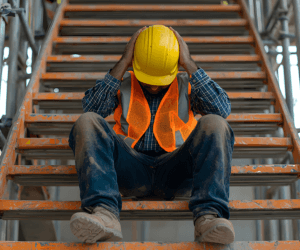 Mental health is emerging as a cornerstone of workplace safety. With the construction industry facing alarming rates of mental health challenges, addressing this issue is no longer optional—it’s essential.
Mental health is emerging as a cornerstone of workplace safety. With the construction industry facing alarming rates of mental health challenges, addressing this issue is no longer optional—it’s essential.
Construction safety is much more than ladder safety and being safe on a job site. It is also about taking care of one’s mental health. Mental health should be as common when discussing safety as safety glasses, helmets, slips, trips, and falls.
“The well-being of workers has become as important as physical safety,” said Mark Cochran, S. M. Wilson’s Chief Operating Officer. “Companies are incorporating resources for stress management, on-site mental health support, and flexible work schedules.”
According to the Associated General Contractors of America, the construction industry has one of the highest rates of suicide at 53.3 per 100,000 U.S. workers. This is four times higher than the national average and five times greater than all other construction fatalities combined. Of the millions of men and women currently working in construction, 83 percent have experienced some form of moderate to severe mental health issue.
Companies and organizations are uniting to ensure that people are no longer left to feel alone in dealing with their issues. As statistics continue to increase, help and hope are available.
The Associated General Contractors of America, Missouri Chapter (AGCMO) offers workers and employers resources, websites, and a variety of materials, including a Pledge of Hope to help raise awareness for suicide and mental health in construction, job-site posters, hardhat stickers, videos related to mental health, and a link to the Suicide Prevention Awareness for Construction podcast. Also, anyone can dial 988 to reach a crisis counselor 24/7 on the Suicide & Crisis Lifeline.
“As a company, we encourage our team members to support and encourage one another as well as access resources available through Member Assistance/Employee Assistance Programs,” Burns said.
“Our industry needs to normalize the discussions around mental health and mental illness to continue decreasing the stigma related to seeking help when needed.”
Safety Culture Shift: From Compliance to Commitment
A notable shift in today’s construction safety culture is the move from simple compliance to a true commitment to safety. Burns explains, “It’s not just about meeting regulations; it’s about creating an environment where every worker feels responsible for their own and their coworkers’ safety.” Training programs are becoming more immersive, emphasizing proactive safety behavior and leadership engagement.
Construction safety evolves quickly, with technological advancements and cultural shifts driving significant changes. From wearable tech to smart helmets and a stronger focus on mental health, today’s safety trends are reshaping the industry.
Burns states, “The goal is to create a holistic safety culture, where each innovation and initiative contributes to a safer, more supportive work environment.”
With ongoing advancements, the future of construction safety looks promising, providing better protection and peace of mind for the workforce.
For additional information about the trends in construction safety, contact Tom Burns at tomburns@smwilson.com or Mark Cochran at markcochran@smwilson.com.
As a trusted partner, the company has built its reputation for 100+ years as a design/build, construction management and general contracting firm. Always putting people first, our company is committed to adding significant value, building client partnerships and job site safety. S. M. Wilson enriches lives by creating spaces to live, work, heal, learn and play. Our expertise is in many specialty markets, primarily education, commercial, municipal, healthcare, industrial and retail. S. M. Wilson continues transforming landscapes and communities throughout the country, especially in the Midwest. For more information, go to smwilson.com.

